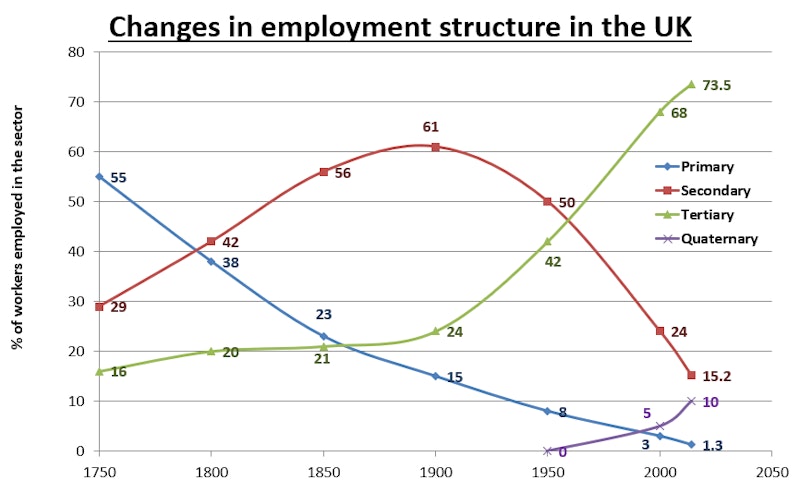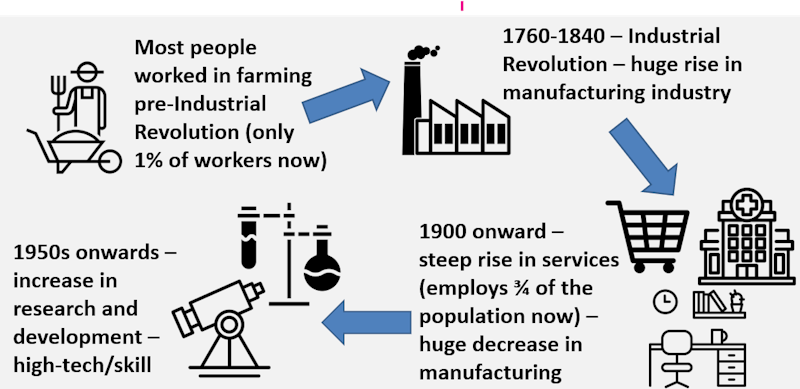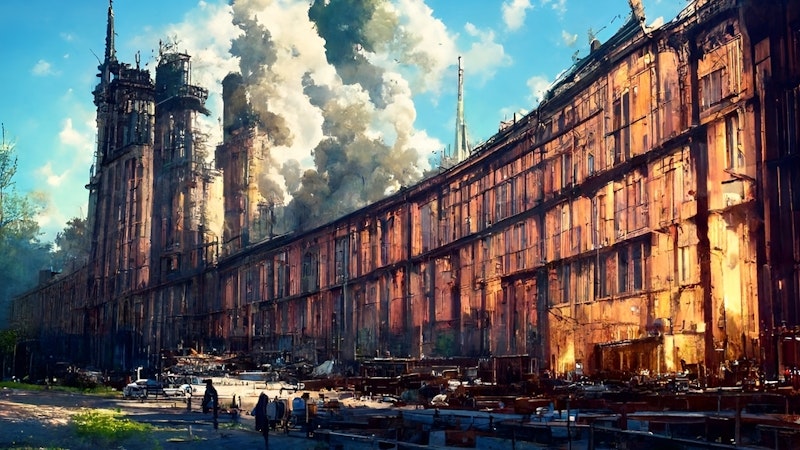Study Notes
GCSE Geography | The UK's Changing Employment Structure (UK Economic Futures 1)
- Level:
- GCSE
- Board:
- AQA, Edexcel, OCR, Eduqas
Last updated 17 Oct 2024
The employment structure of a country is how the workers are divided into different types of economic activity - i.e. the percentage of workers in each category.
The economic sectors
- Primary sector - this involves extracting raw materials, e.g. farming, fishing, forestry, mining, quarrying
- Secondary sector -making, building or processing raw materials into finished products, usually in factories (also known as manufacturing sector)
-
Tertiary sector - providing a service, e.g. teachers, doctors, cleaning staff, drivers, professional sports players (also known as the service sector)
- Quaternary sector – high-tech research to develop new things which is highly skilled and usually involves a high level of qualifications (also known as research and development)
The changing economic structure of the UK
Over the last few hundreds of years the UK's employment structure has shifted significantly as you can see in this graph...

These changes are also summarised in this graphic...

Up until 1800 most UK workers were employed in agriculture and mining. These are primary industries because they those that involve extracting raw materials, in this case growing crops and raising livestock, and mining coal and iron ore.
But between 1750 and 1900 the Industrial Revolution happened in the UK, and everything changed. Manufacturing industries grew rapidly meaning that thousands of people flocked to towns and cities to work in factories, making steel, building ships or working in cotton mills (like the one pictured below). Thousands of people also worked in dockyards which were importing goods from the colonies.
This was the growth of the secondary sector, and these jobs were considered to be better paid and more reliable. However the conditions in Victorian factories were very harsh - there were no health and safety laws about running factories as they hadn't been needed before, therefore workers often operated dangerous machinery which could, and frequently did, cause serious injuries. Pay was usually quite poor and the hours were very long - often workers were forced to work through the night.

Towards the end of 20th century we saw another big shift - deindustrialisation occurred and manufacturing saw a huge decline (see separate study notes).
Jobs in factories and mills were replaced by service jobs in the tertiary sector. This is a really varied sector and is what most people in the UK work in - it includes office work, retail, healthcare, education, finance, hospitality, entertainment - all sorts of jobs!
More recently we have seen the emergence of the quaternary sector - these are high-tech and highly specialized jobs focused around research and development - this is often referred to as the knowledge sector. This is a really quick growing sector and includes biotechnology, software development, the advancement of artificial intelligence and pharmaceuticals (pictured below). This sector played a huge role in the covid pandemic of 2020-21, including the development of vaccines, the track and trace system and software that enabled us to work from home more effectively.
The UK is now classed as a post-industrial economy (see separate study notes).

You might also like
Changing Places - A-Level MCQ Quiz
Quizzes & Activities

Ghost Town - a fantastic representation of place
11th January 2023

Trouble at'Mill
19th January 2023